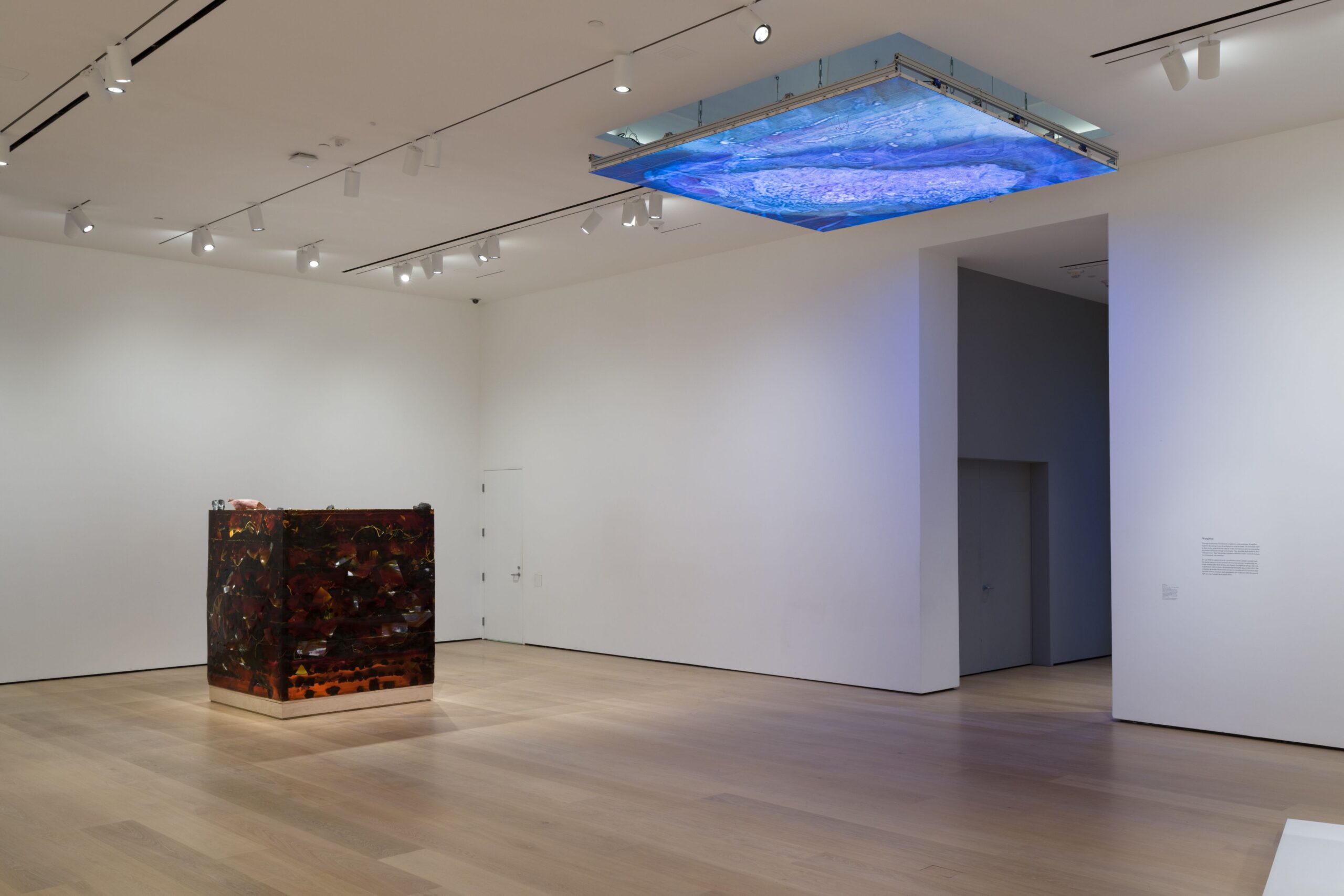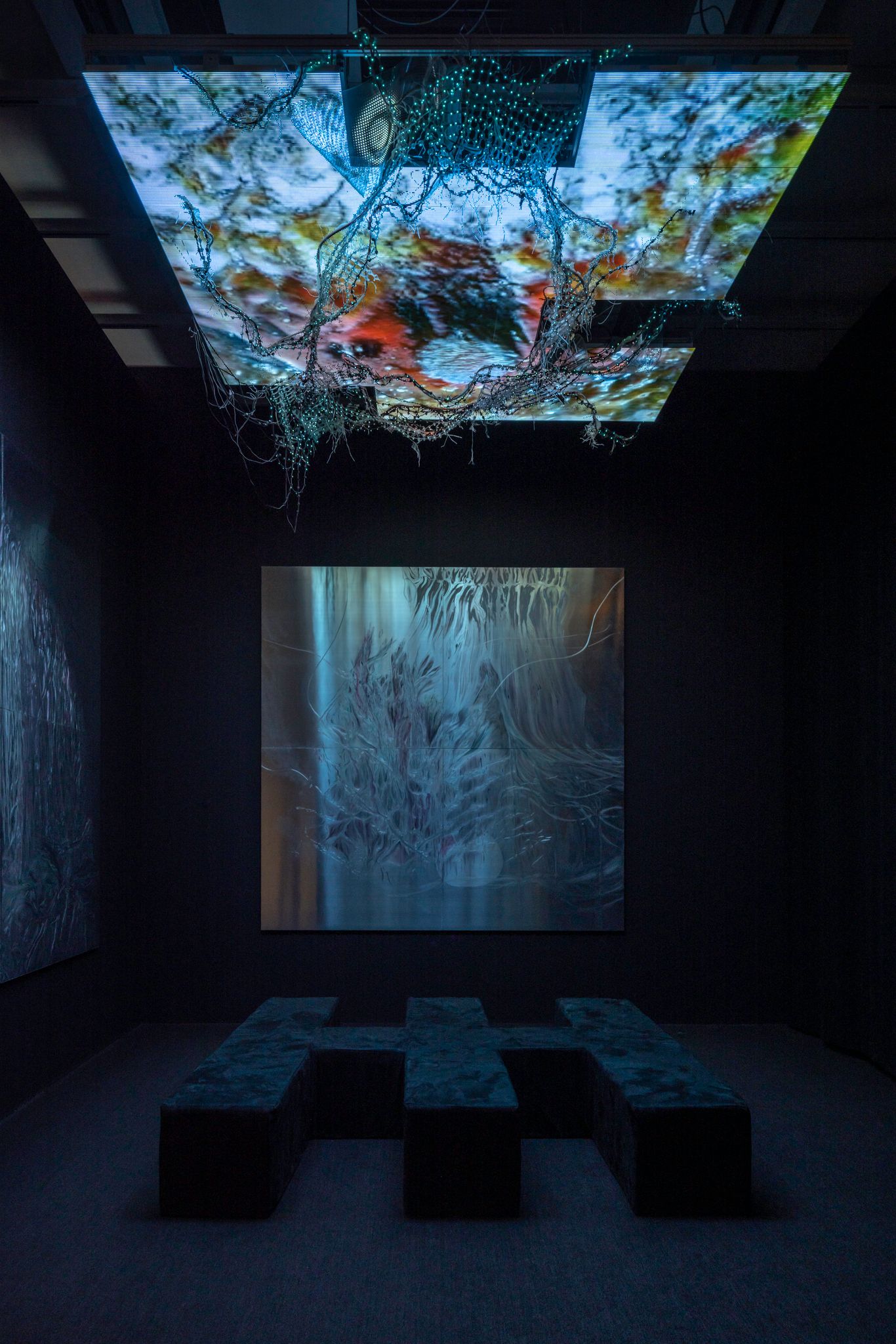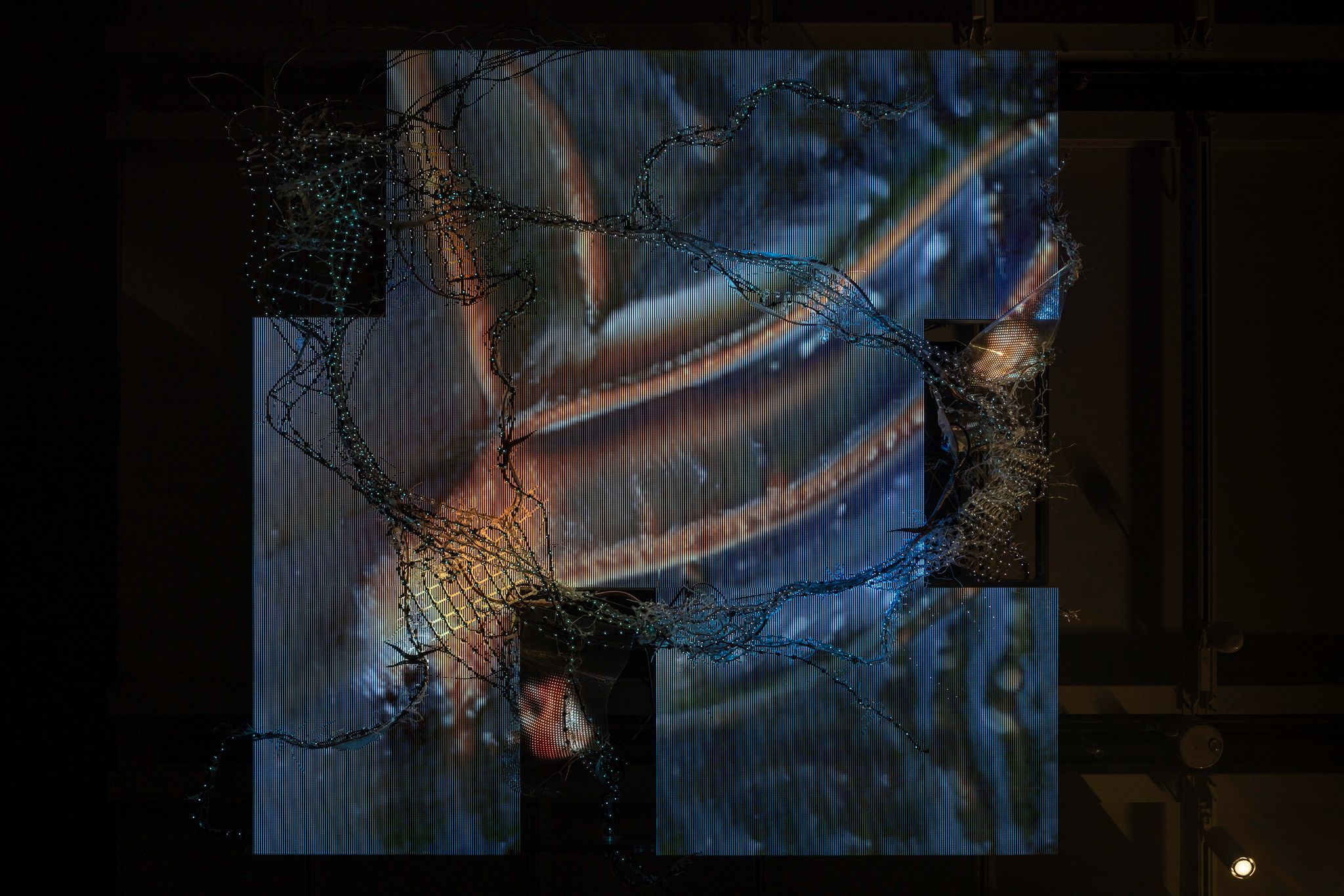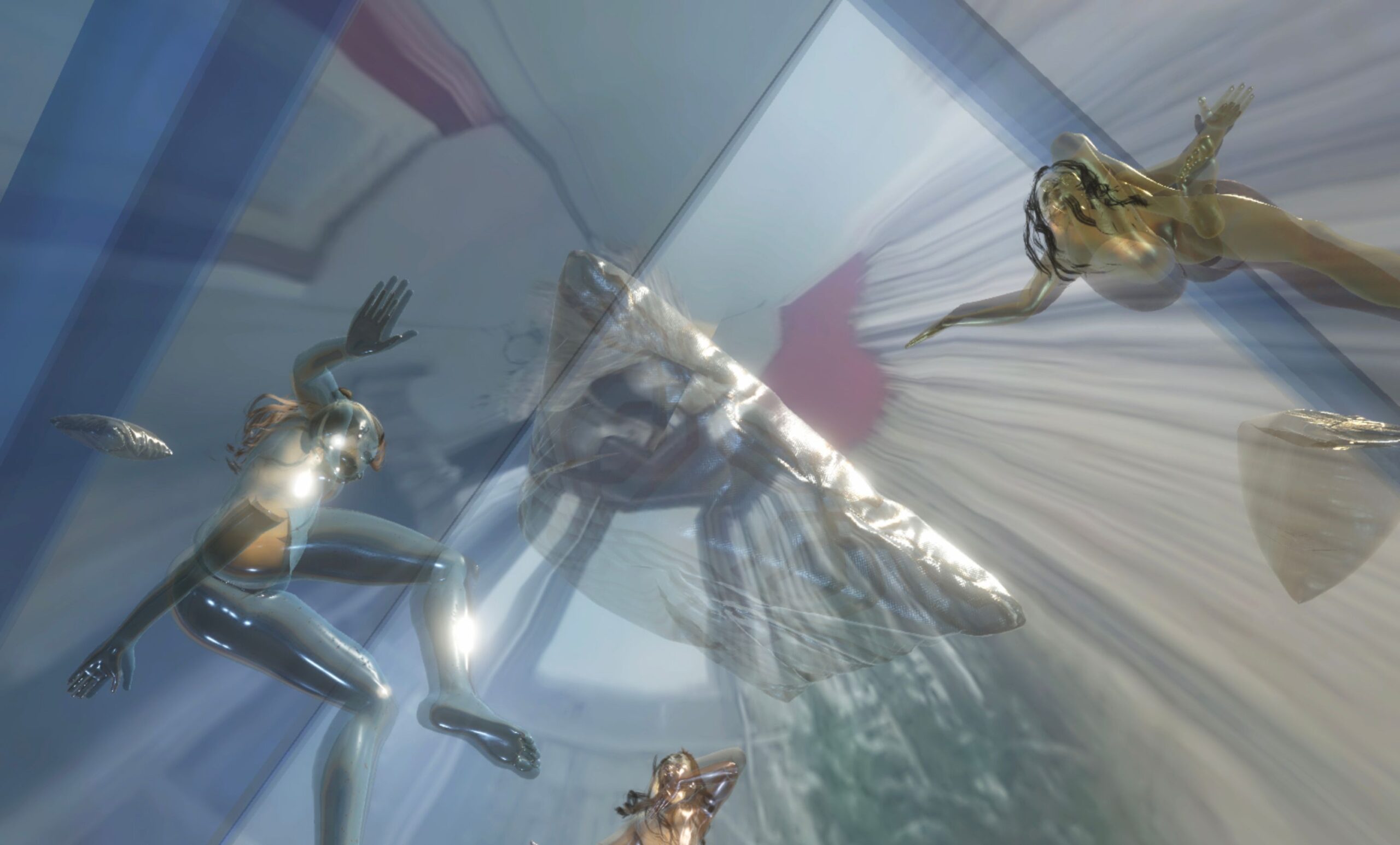WangShui: Uncertainty in the Network
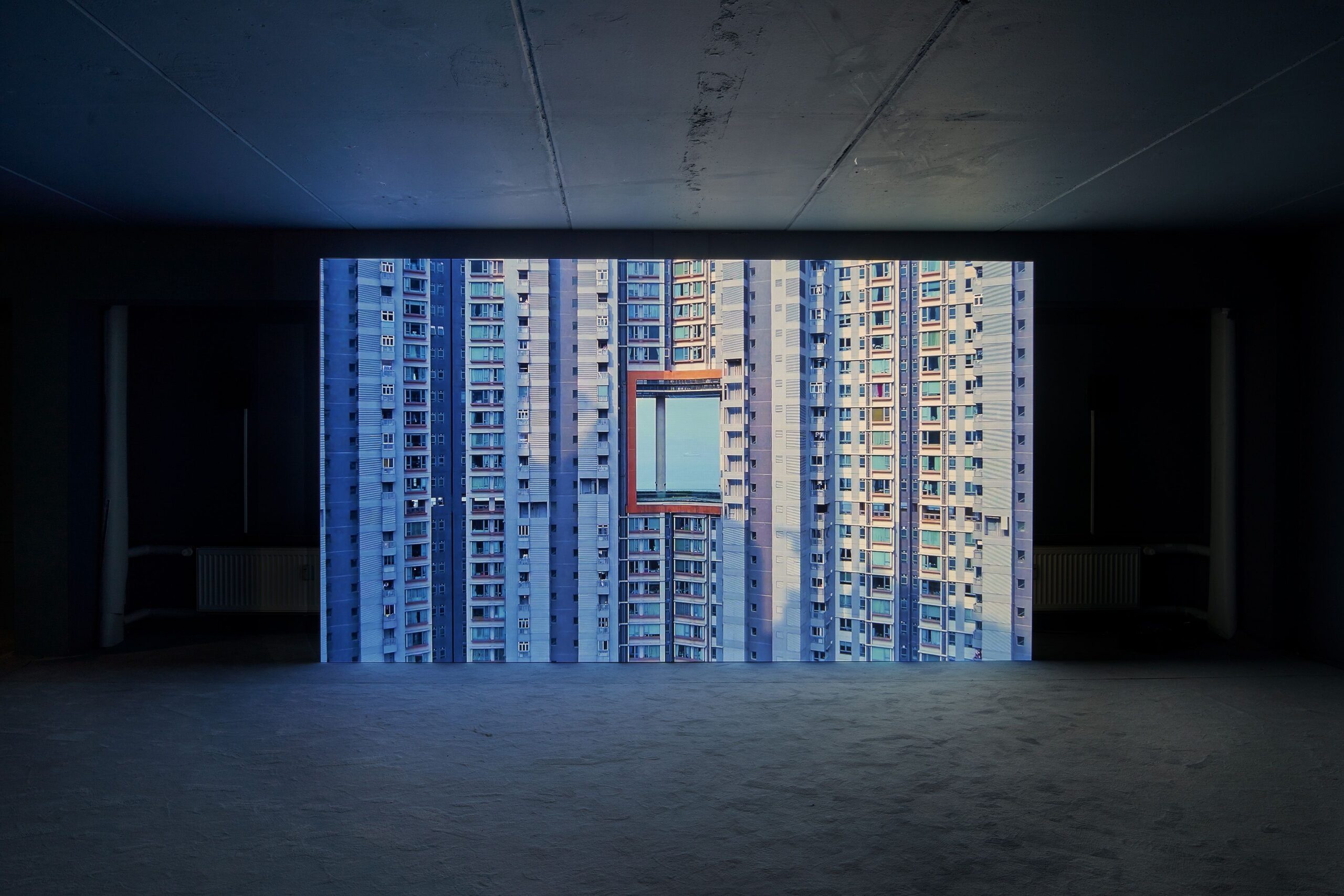
Wangshui, From Its Mouth Came a River of High-End Residential Appliances, 2018, Single channel video installation, looped [photo: Alwin Lay; courtesy of the artist and High Art, Paris/Arles]
Share:
One of my earliest memories of the artist WangShui is of cats. Cats were the focus of their undergraduate thesis exhibition at UC Berkeley in 2010. Cats had recently taken over the internet, dominating page views and launching oceans of memes. WangShui mapped black boxes over the faces of internet video cats to block out their empathy-inducing triangle of big eyes and little noses that biologically compels us to experience an image as “cute.” We stood together and watched their film, gasping and sighing involuntarily, and in unison, every time a flash of iris or a pink nostril crept into frame.
A few years earlier, I saw Bruce Nauman’s early works in A Rose Has No Teeth at the University of California, Berkeley Art Museum and Pacific Film Archive and noticed how many of Nauman’s mature concerns could be seen, in a simplified form, within his MFA projects at UC Davis in the mid-1960s. Looking back, I can see a similar phenomenon occurring in WangShui’s work. From the first, they have been concerned with affect, desire, and absence in a digital landscape where embodiment is fungible and human responses are manipulable. As culture has moved progressively more online since then, their work has evolved to incorporate more sophisticated methods and less predictable outputs.
WangShui uses artificial intelligence networks to produce animated visuals that synthesize abstract images from a database of photographic representations. In Scr…pe (2021), which was commissioned by the Hammer Museum in Los Angeles, the work’s database contains images of animal skins, cells, plants, and other elements of the natural world. The resulting images are not literal representations of a posthuman species. Rather, the general adversarial network (GAN) algorithm produces an evolving cellular structure that the artist likens to “flesh,” or “a posthuman tissue sample.”1 The eye perceives organic hues—sky blue, fleshy pink, forest green—fused into an undulating, softly morphing surface. This two-dimensional, digitized flesh is illuminated and further transformed by the natural light that enters the gallery through the skylight, below which Scr…pe is installed. Viewers must look up at the ceiling to see the work, shifting the typical relationship between body and object.
Wangshui, Scr…pe, installation view, 2021 [photo: Jeff Mclane; courtesy of the artist, High Art, Paris/Arles and Hammer Museum, Los Angeles]
Scr…pe II (2022), which was exhibited in the 2022 Whitney Biennial, incorporates a generative ceiling-mounted LED installation and the artist’s signature woven LED video sculptures into a chapel-like space with two large aluminum panel paintings that WangShui also created in collaboration with an AI. In this installation, there are multiple GANs at work, which are integrated or “collaged”2 together, meaning that imagery generated by individual GANs is also absorbed and recalibrated into animations produced by another AI network. Sensors absorb atmospheric data from the imagery as it plays, and from the audience. That information further influences the abstract images that viewers see. To situate this work within the lineage of conceptual art, WangShui presents a high-tech answer to Robert Morris’ Box With the Sound of Its Own Making (1961). Unlike the stylized and hyper-realistic imagery generated by stable diffusion models as a product of iterative learning, GAN models create visual static that does not readily refine itself into recognizable imagery. Internet trends aside, stable diffusion models are adept at producing the stylistic hallmarks of recognizable “art,” but GANs are more likely to produce new visual forms. Working with programmers Moises Sanabria and Fabiola Larios, WangShui has molded a process-based AI practice such that their work perennially shows us the effort it is exerting to make itself.
To make and remake oneself in perpetuity is an inherently queer act. In WangShui’s breakthrough film, From Its Mouth Came a River of High-End Residential Appliances (2017–2018), their lilting voiceover narrates a personal transformation of gender. The artist likens it to “ideological therianthropy (shapeshifting)”3 in the manner of a dragon passing through one of the feng shui–inspired “dragon gates” that penetrate the skyscrapers encircling Hong Kong’s Victoria Harbour. Hong Kong and neighboring Taiwan provided safe havens to feng shui practitioners persecuted by China’s Cultural Revolution, and in turn the feng shui practitioners ensured that Hong Kong’s dragons would always be able to fly unfettered from the mountains to drink from the sea. At one point, the drone operator filming through the gates asks the artist what motivates their undertaking. WangShui replies, “I explained to him that it was the only way I could become who I wanted to be.”4 WangShui is interested in these holes, orvoids, as “anti-monuments”5 that refuse global market rationalism and productivity logic. Nonbinary trans identity adheres to a similar anti-logic. To refuse gender norms is to defy categorization, classification, and commodification.
Wangshui, Scr∴ pe II (Isle of Vitr∴ ous), installation view, 2022 [photo: Alon Koppel; courtesy of the artist, High Art, Paris/Arles and Whitney Museum of Art, New York, USA]
Wangshui, Scr∴ pe II (Isle of Vitr∴ ous), installation view, 2022 [photo: Alon Koppel; courtesy of the artist, High Art, Paris/Arles and Whitney Museum of Art, New York, USA]
WangShui’s interest in individual and collective self-construction continues in their newest body of work, Certainty of the Flesh, which is to debut in March 2023 at Rockbund Art Museum in Shanghai, before traveling in September to Haus der Kunst in Munich. In an online conversation presented by the Guggenheim, WangShui and critic Nora Khan spoke of their shared love of reality television and their embrace of what many would consider lowbrow or feminized entertainments—ones that dwell in the realm of affect, sexuality, and self-invention.6 For this latest work, WangShui has trained an algorithm to simulate characters based upon archetypes gleaned from reality television. For example, women portrayed as “villains” are often the cast members more likely to strike out on their own rather than to follow the group. Although these archetypes are often generated by show producers’ manipulation of cast members, and by edited footage, they also respond to our collective expectations and unconscious fears about cooperation, independence, and exploitation. Conversely, WangShui’s reality heroines within the AI space are unfettered by human demands for social reproduction. They inhabit a virtual utopia where they can dedicate all their energies to creating and re-creating themselves.
Wangshui, Certainty of the Flesh, 2023, digital still [courtesy of the artist, Solomon R. Guggenheim Museum and Haus Der Kunst.]
As online technologies have become exponentially more sophisticated since 2010, so, too, has WangShui’s work evolved, along with their persona, to inhabit the expansive nature of digitally embodied experience. Less enamored of technology for its own sake, WangShui is invested in technology’s potential to liberate us from our self-imposed limitations. They begin by dissolving boundaries between our human selves and the biological Other, be that organic nature or artificial life. Contemporary culture is saturated with calls to fill our inner voids with overconsumption. In WangShui’s work, passing through the void is the only way to become who we want to be.
Anuradha Vikram is a writer, curator, and educator. They are co-curator of the 2024 Portland Biennial and guest curator of the Getty Pacific Standard Time Art and Science initiative at UCLA Art|Sci Center. Vikram’s book Decolonizing Culture (Sming Sming Books, 2017) helped initiate a global movement to decolonize arts institutions and monuments. They have been published by Paper Monument, Heyday Books, Routledge, and Oxford University Press. They are an editorial board member at X-TRA and an editor at X Artists’ Books. Vikram is faculty in the UCLA Department of Art. They hold an MA in curatorial practice from California College of the Arts and a BS in studio art from NYU.
References
| ↑1 | Hammer Museum, No Humans Involved Facebook post, November 2, 2021. online. |
|---|---|
| ↑2 | Sarah Cascone, “‘They Are About Capturing the Process of Merging’: How Artist WangShui Collaborated With A.I. to Make Paintings for the Whitney Biennial,” Artnet May 12, 2022. online. |
| ↑3 | Horizontal Vertigo: WangShui,” Julia Stoschek Foundation, 2019. online |
| ↑4 | “From Its Mouth Came a River by WangShui,” Transfer, November 19, 2019. |
| ↑5 | “From Its Mouth Came a River by WangShui,” Transfer |
| ↑6 | “Artist Talk: Certainty of the Flesh ” interview by ora N. Khan, Guggenheim Museum, December 8, 2022. online. |
